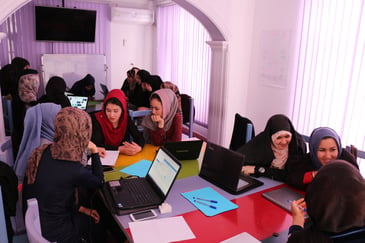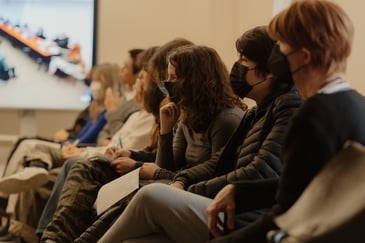Globalization and Its Impact on Indigenous Cultures

Globalization has many physical manifestations as evidenced by the constant movement of products, goods, and services that cross international borders every day. The Global South which sends its commodities into a volatile market, and provides cheap labor for the world’s major corporations, has long voiced its disappointment at the injustice of unequal trade relations and international regulatory organizations. The invasive development in the South to service the growth-based economies in the North has a negative correlation with a sustainable environment (Iqbal). Thus, they see firsthand the social and environmental repercussions that a culture of consumption creates in the world.
How does globalization affect culture?
Yet the greatest social and environmental effects remain out of view of most of the world, in the heart of our indigenous societies. According to Dr. Erica-Irene Daes, who was also the driving force behind the United Nations Declaration on the Rights of Indigenous Peoples, ninety-five percent (95%) of the world's Indigenous peoples live in developing countries (Daes). In a guest lecture in Sydney, she articulates the following:
“Indigenous peoples today stand at the crossroads of globalization. In many ways, indigenous peoples challenge the fundamental assumptions of globalization. They do not accept the assumption that humanity will benefit from the construction of a world culture of consumerism. Indigenous peoples are acutely aware, from their own tragic experience over the past 500 years, that consumer societies grow and prosper at the expense of other peoples and the environment” (Daes).
Globalization has certainly had an impact on the world’s indigenous communities and sustainable ways of life, and the surrounding ecosystems in which they live (Iqbal).
The vast majority of indigenous cultures are also Mother Earth’s greatest stewards and defenders, yet many are at risk of losing their livelihoods, health, and security, due to governments and corporations disrespecting their property rights and exploiting natural resources. This is especially important in the Amazon. There live an estimated 1.7 million people belonging to some 375 indigenous groups that live within roughly 3,344 indigenous territories (ITs) and approximately 522 protected natural areas (PNAs). While the protected natural areas serve as biodiversity conservation, the indigenous territories are intended to “safeguard the rights of indigenous peoples to their land and livelihoods for social, cultural, and equity reasons” (Walker).
The lungs of the earth
Moreover, what happens to these tribes in the Amazon, determines the fate for everyone and our chances of easing climate change. The Amazon is considered to be the largest carbon sink, “the lungs of the planet,” and climate scientists argue that its ability to store carbon is “central to any comprehensive climate stabilization strategy” (Walker). Increasingly, scientists are also recognizing the importance of indigenous people and local communities (IPLCs) as critical protectors of the forests, and whose communities serve as “buffers” against large-scale carbon emissions in the Amazonian region. “With deforestation increasing, IPLCs provide a global environmental service that merits increased political protection and financial support” (Walker).
The impact of globalization on human rights
When both political and financial support falter, we can consider judicial support. But what is the role of international law in protecting indigenous peoples or vulnerable populations? What institutions exist with enough authority to serve states or corporations for “crimes against humanity”? The United Nations often cannot get involved in issues that do not fall under federal jurisdictions, and increasingly the human rights abuses are caused by stateless global corporations. Other times, the corporations act within a state that looks the other way. For example, the Brazilian mining company Vale S.A. paid a one-time fine of $45M to the Brazilian environmental agency, after a tailing dam collapsed and killed an estimated 250 people and nearly destroyed the village of Brumadinho. Since then, government pressure on Vale S.A. has receded under the watch of conservative President Bolsonaro. When their own state failed, what international governing body can ensure that the workers’ families and residents of the now uninhabitable parts of the village are at all compensated for their tragic losses?
While the WTO is concerned with the regulation of international trade (albeit with questionable bias in favor of developing nations), there exists no international justice system with enough authority to defend the world’s most vulnerable populations. Dr. Daes questions why the definition of ‘crimes against humanity’ does not include “the physical destruction of the ecosystems on which they depend for their livelihoods, or forced assimilation” in the International Criminal Court Statute (Daes). Indeed I subscribe to the ancient Sanskrit philosophy that when one takes more than she needs, or imposes upon another, it is the same as stealing.
The great cost of doing nothing
In closing, it is undeniable that globalization has negatively affected the livelihoods of developing nations and particularly the vulnerable indigenous populations. These inequalities will persist without a strengthening of the enforcement of international norms like the UN Global Compact, which identifies corporations in violation of human rights, labor rights, the environment, and business ethics. The world needs thoughtful leadership and careful execution of the enforcement of international norms in order to not reinforce existing inequalities and overlay more punitive measures on developing countries than already exist. However, the most controversial companies are also the world’s most powerful nations so the challenge is great.
In closing, the alternative of upholding the status quo means that not only do we risk more injustice that may lead to increased loss of biodiversity on earth, but more importantly we risk losing cultural diversity and the valuable ancestral knowledge of our indigenous peoples. The Iqbal International Institute for Research & Dialogue (IRD) describes the danger to all of us if we do nothing to protect our indigenous populations from the threat of globalization:
“This environmental threat owing to overdevelopment is to all creatures on the surface of this earth including the humans. Just like there are endangered species, there were endangered languages, cultures and ways of life that risked extinction because of the imposition or voluntary subscription to the modern ways of life” (Iqbal).
We can, must, and will do better.
Interested in how sustainable development ideals can lead to environmental justice reforms? Download our guide, "The State of Environmental Justice" to learn more!
Sources:
- Iqbal International Institute for Research & Dialogue (IRD). (2011) “Globalization and its Impact on Indigenous Cultures.” https://www.iiu.edu.pk/wp-content/uploads/downloads/ird/GLOBALIZATION_AND_ITS_IMPACT_ON_INDIGENOUS_CULTURES.pdf Accessed on 5/3/2020.
- Walker, W. S. et al. (2020). The role of forest conversion, degradation, and disturbance in the carbon dynamics of Amazon indigenous territories and protected areas. Proceedings of the National Academy of Sciences, 117, 3015–3025. https://doi.org/10.1073/pnas.1913321117 Accessed on 5/3/2020.
- Daes, Dr. Erica-Irene (2004). “The impact of globalization on Indigenous Intellectual Property and Cultures.” https://www.humanrights.gov.au/about/news/speeches/impact-globalization-indigenous-intellectual-property-and-cultures Accessed on 5/3/2020.





